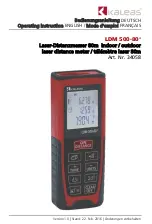
Function and design
multi N/C pharma HT
28
TOC analysis can be used when the sample contains easily purgeable organic substances
such as benzol, cyclohexane, chloroform, etc. If the TIC content of the sample is signifi-
cantly above the TOC content, TOC analysis should not be applied.
TN
b
detection is possible in parallel to TOC detection.
3.4.3
TIC analysis
TIC: Total Inorganic Carbon
In TIC analysis, the total inorganic carbon from carbonates and hydrocarbonates, as well
as dissolved CO
2
, is detected.
Cyanides, cyanates, isocyanates and carbon particles are not detected.
An aliquot of the sample is dosed directly into the TIC reactor to determine the inorganic
carbon (TIC). The CO
2
is purged and detected.
3.4.4
NPOC analysis
NPOC: Non-purgeable Organic Carbon
During the NPOC analysis, the total non-purgeable organic carbon content of a sample is
detected.
The sample is acidified to pH <2 outside of the analyzer with acid (HCl (2 mol/l)). The
generated CO
2
is purged externally, e.g., in the autosampler. The analyzer then deter-
mines the remaining organic carbon in the sample.
Other highly volatile organic compounds are purged with the CO
2
. The NPOC analysis
should not be used when the sample contains easily purged organic substances.
NPOC analysis according to the NPOC plus method
This method was developed especially for the detection of low TOC content in samples
with high TIC content or a high level of dissolved CO
2
. The NPOC method is generally
recommended for the analysis of such samples. For high and, in particular, unknown TIC
content, very long time periods (t > 10 min) may, however, be required for complete
purging of the CO
2
. This is why the inorganic bound carbon is purged externally with this
method.
The NPOC plus method process is a combination of the NPOC and the differential
method.
As with NPOC analysis, the sample is acidified (pH <2) outside of the analyzer. Immedi-
ately before the analysis of the sample, the greater part of the carbon dioxide generated
is purged externally. Afterwards, the remaining organic carbon (TOC) from the sample
prepared in this manner is determined using the differential method.
The TIC value determined using this method is only a calculated variable and of no ana-
lytical relevance.
Highly volatile organic substances are also purged during the sample preparation and
not detected for this reason.
TN
b
detection is possible in parallel to the NPOC and NPOC plus detection.
3.4.5
DOC analysis
DOC: Dissolved Organic Carbon
In DOC analysis, the organic carbon remaining in the filtrate after the sample is filtered
is determined. The filter typically has a pore size of 0.45 µm.
















































